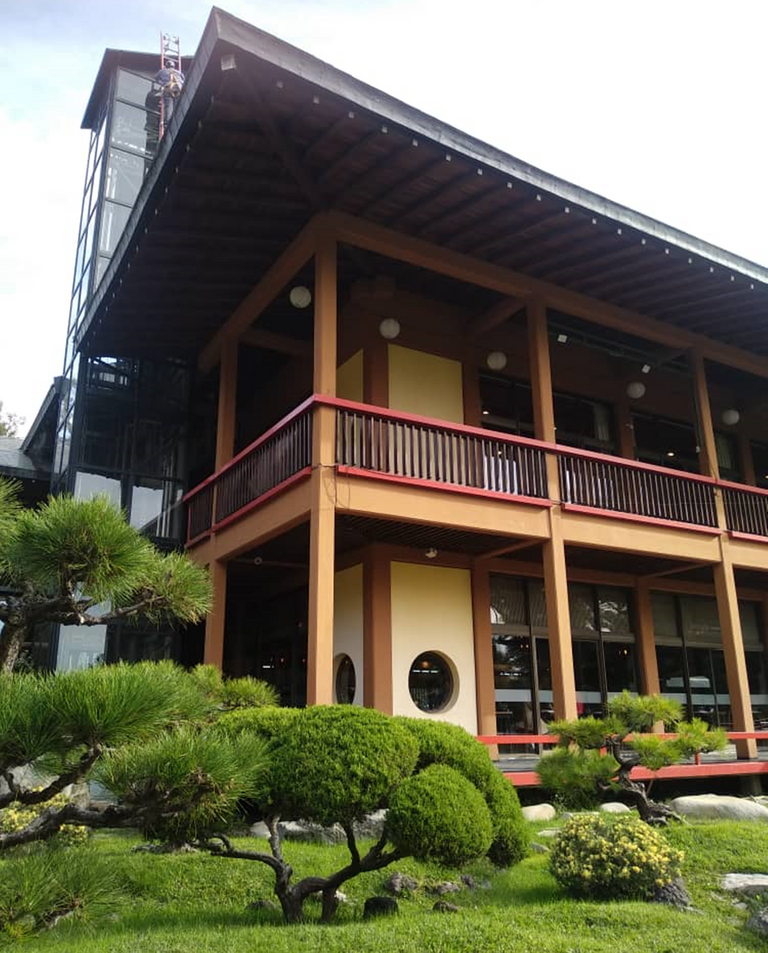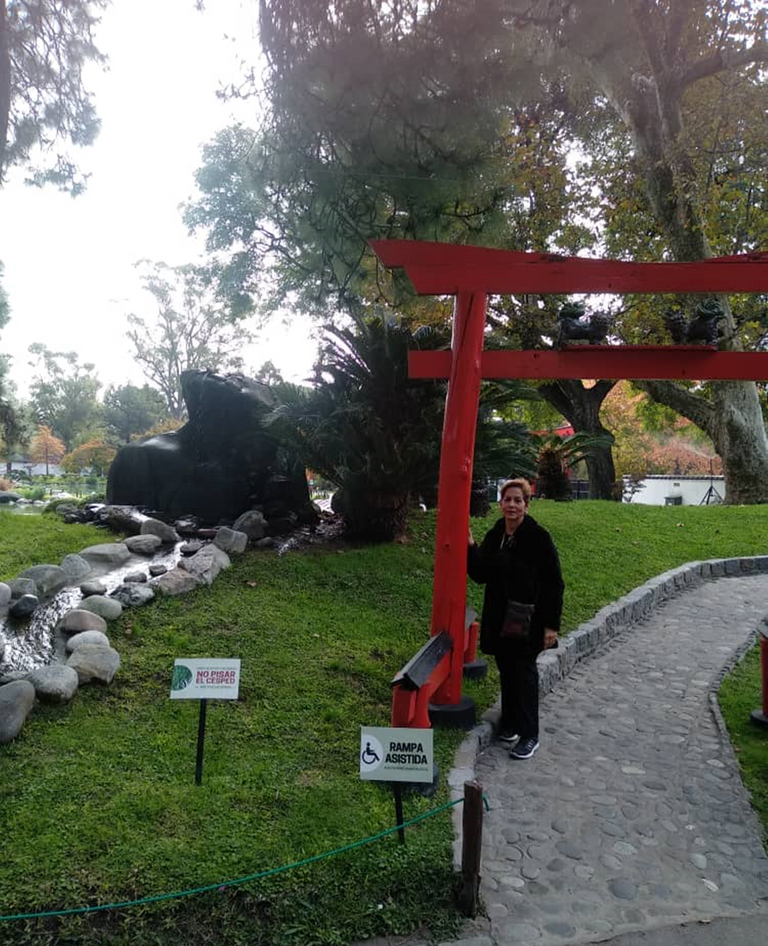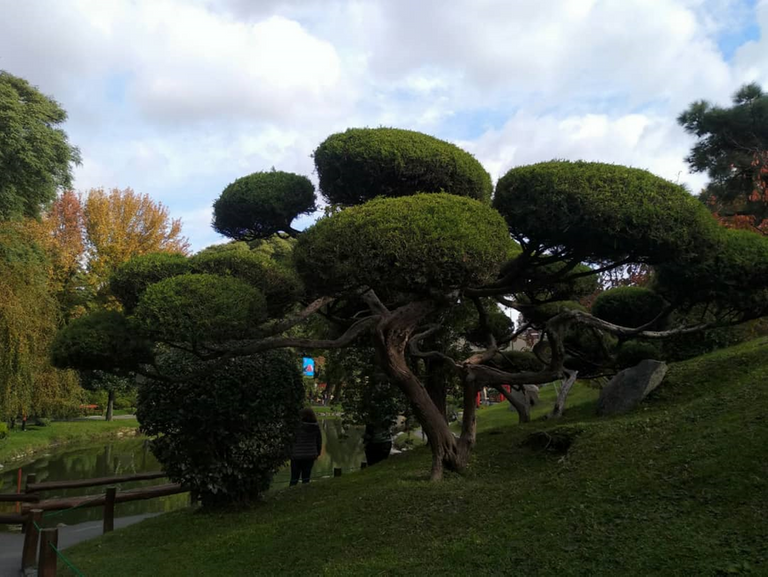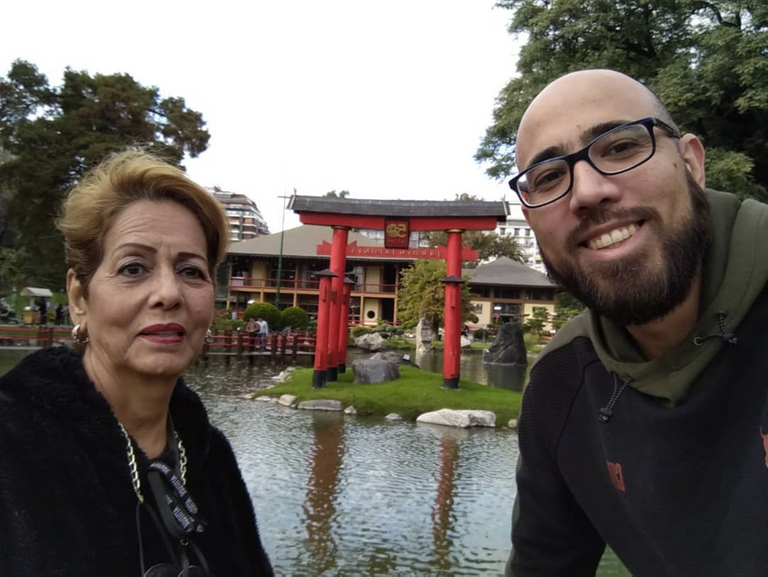
On May 11 of this year, my sister Myrna and her son Edgar visited one of the most striking gardens in the city of Buenos Aires, it is the "Japanese Garden", located in one of the most exquisite areas of the city: Palermo Woods. The photos were taken at my express request, following certain reference patterns in order to achieve what is necessary to present them to the Hive communities. The photos, therefore, are family property.

The Japanese Garden of Buenos Aires, built in 1967 to celebrate Prince Akihito's visit to Argentina, is one of the most pleasant places surrounded by the forests of the Palermo neighborhood in Buenos Aires. It is considered the largest Japanese-style park built outside of Japan, respecting the elements of Japanese culture.

The fundamental characteristic of the park, after its oriental beauty, is the harmony and the experience that visitors acquire with the tranquility that is breathed there and the richness of nature; in short, an external peace that we internalize, spreads and rejoices us.

The Japanese Garden was built with the economic effort of the Japanese community, whose resources were achieved in just 50 days, and donated to the city of Buenos Aires in gratitude to its inhabitants and the country that welcomed them in times of immigration. It covers a two-hectares (five-acre) piece of land, located in the northeast corner of “Parque Tres de Febrero”.

It is a true aesthetic pleasure to walk surrounded by bonsai, azaleas, kokedamas, and orchids, by lantern light, through this park, which has, in addition to its garden, a building that houses a center for Japanese cultural activities, a library, a tea (Chashitsu), where the traditional Japanese tea ceremony is held.

This beautifully decorated place with elements imported from Japan, some of which are more than 100 years old, was built by hand; To complete the visit to this building, you can tour the art room, taste a Japanese dish in a Japanese food restaurant, stroll through the nursery and observe the cultivation of bonsai or see and buy Japanese handicrafts in a store located there for that purpose.

The Park is a museum synthesis, where nature and the work produced by the hand of man coexist harmoniously. The time to visit it varies with the interests of the visitor, physically it can be covered in half an hour, but many are delighted and walk it for hours to enjoy that "microcosm of paradise" as an Argentine writer has called it.

The garden has a great variety of Japanese plants and lakes full of koi fish ("carp"), which are crossed by means of significant bridges, symbols of traditional ethical, religious, and cultural values of the Japanese country, such as the "Bridge of God” of religious thickness, the “Truncated Bridge” that represents the search for the island of miraculous remedies and, finally, the “Zigzag bridge” or bridge of decisions.

Throughout the park, there are plates with inscriptions that identify the species of plants, flowers, and trees. Fish can be fed in the lakes, and presentations on Japanese culture can often be heard.


In 1977, the Park was redesigned by the landscape engineer Yasuo Inomata, following the model of the Zen Garden, respecting the existing harmony and balance.

Over the years, the Garden has not lost its charm and prestige, which is why it is considered by the inhabitants of the big city as a "lung of harmony and tranquility in the middle of the big city". Officially, the Ministry of Tourism of the capital declared the Garden as a site of tourist interest, and, in 2008, the National Government declared it "well of historical and artistic interest of the Nation".



El 11 de mayo del presente año, mi hermana Myrna y su hijo Edgar, visitaron uno de los jardines más llamativos de la ciudad de Buenos Aires, se trata del “Jardín Japonés”, ubicado en una de las zonas más exquisitas de la ciudad: los bosques de Palermo. Las fotos fueron tomadas por mi solicitud expresa, siguiendo ciertos patrones de referencia a objeto de lograr lo necesario para presentarlas a las comunidades de Hive. Las fotos, por lo tanto son de propiedad familiar.

El Jardín japonés de Buenos Aires, construido en 1967 para celebrar la visita del Príncipe Akihito a Argentina, es uno de los lugares más agradables rodeado por los bosques del barrio de Palermo en Buenos Aires. Es considerado el parque de estilo nipón más grande construido fuera del Japón, respetando los elementos propios de la cultura japonesa.


La característica fundamental del Parque, después de su belleza oriental, es la armonía y la experiencia que los visitantes adquieren con la tranquilidad que allí se respira y la riqueza de la naturaleza; en resumen, una paz exterior que se interioriza, nos contagia y regocija.

El Jardín Japonés fue construido con el esfuerzo económico de la colectividad japonesa, cuyos recursos fueron logrados en escasos 50 días, y donado a la ciudad de Buenos Aires en agradecimiento a sus habitantes y al país que les acogieron en tiempos de inmigración. Cubre un terreno cuya extensión es de dos hectáreas (cinco acres), ubicado en la esquina noreste del Parque Tres de Febrero.

Produce un verdadero placer estético caminar rodeado por bonsáis, azaleas, kokedamas y orquídeas, a la luz de faroles, por este parque, tiene, además de su jardín, un edificio que alberga un centro de actividades culturales japonesas, una biblioteca, una casa de té (Chashitsu), donde se celebra la tradicional ceremonia del té japonesa.

Este lugar bellamente ornamentado con elementos importados del Japón, algunos con una vetustez de más de 100 años, fue construido en forma artesanal; para completar la visita a este edificio se puede recorrer la sala de arte, degustar un plato japonés en un restaurante de comida japonesa, pasearse por el vivero y observar el cultivo de bonsáis o ver y comprar las artesanías japonesas en una tienda localizada allí para tal fin.

El Parque es una síntesis museística, donde conviven armoniosamente la naturaleza y la obra producto de la mano del hombre. El tiempo para recorrerlo varía con los intereses del visitante, físicamente se puede recorrer en media hora, pero muchos se deleitan y lo transitan por horas para disfrutar ese “microcosmo de paraíso” como lo ha llamado un escritor argentino.

El jardín cuenta con una gran variedad de plantas japonesas y lagos repletos de peces koi (“carpas”), que se atraviesan por medio de significativos puentes, símbolos de valores éticos, religiosos y culturales tradicionales del país nipón, como el “Puente de Dios” de espesor religioso, el “Puente truncado” que representa la búsqueda de la isla de los remedios milagrosos y, por último, el “Puente Zigzag” o puente de las decisiones.


A lo largo del parque se encuentran las placas con inscripciones que identifican las especies de plantas, flores y árboles. Se pueden alimentar los peces en los lagos y, a menudo, se pueden escuchar presentaciones sobre la cultura japonesa.

En el año 1977, el Parque fue rediseñado por el ingeniero paisajista Yasuo Inomata, siguiendo el modelo el Jardín Zen, respetando la armonía y el equilibrio preexistente.
Con los años el Jardín no ha perdido su encanto y prestigio por lo que es considerado por los habitantes de la gran urbe como un “pulmón de armonía y tranquilidad en medio de la gran ciudad". Oficialmente, la Secretaría de turismo de la capital declaró al Jardín como un sitio de interés turístico y, en 2008, El Gobierno Nacional lo declaró “bien de interés histórico y artístico de la Nación".










Congratulations, your post has been added to Pinmapple! 🎉🥳🍍
Did you know you have your own profile map?
And every post has their own map too!
Want to have your post on the map too?
Dear friends of Pinmapple, as always I appreciate your kindness in placing my post on your map. congratulations to everyone
oh wow! that looks like a pleasantly calming walk by that bridge on the water 😃 it's also amazing to see how they took great effort in recreating the similar looking flora to Japan, definitely looks like such a beautiful place! 😊 thank you for sharing about this!

https://d.buzz
!ALIVE
Hello friends of Ilovewintergem. Indeed, this garden is a delightful place to walk, admire the Japanese culture and marvel at the abundant vegetation. It has been a pleasure to be able to share with you this family visit to the place. Receive my best regards
Hi! Do join the #dbuzzphotochallenge (☞゚ヮ゚)☞
https://peakd.com/hive-194913/@dbuzz/photo-fridays-have-some-photo-fun-and-have-a-shot-at-winning-10-hive-v
@besamu! You Are Alive so I just staked 0.1 $ALIVE to your account on behalf of @ilovewintergem. (4/10)
The tip has been paid for by the We Are Alive Tribe through the earnings on @alive.chat, feel free to swing by our daily chat any time you want.

Hiya, @lizanomadsoul here, just swinging by to let you know that this post made it into our Honorable Mentions in Daily Travel Digest #1652.
Your post has been manually curated by the @pinmapple team. If you like what we're doing, please drop by to check out all the rest of today's great posts and consider supporting other authors like yourself and us so we can keep the project going!
Become part of our travel community:
Hello @lizanomadsoul, thank you for placing my post into your Honorable Mentios in Daily Travel Digest #1652. Likewise, to the Pinmaple group for having manually curated my post. I will look carefully at the other posts in order to lend them my support. Thanks again
My pleasure @besamu :) It is a shame I couldn't see that place when I was in Buenos Aires! Seems like I should have stayed there a few more days. Maybe next time ;)
Thank you for sharing this amazing post on HIVE!
Your content got selected by our fellow curator @priyanarc & you just received a little thank you via an upvote from our non-profit curation initiative!
You will be featured in one of our recurring curation compilations and on our pinterest boards! Both are aiming to offer you a stage to widen your audience within and outside of the DIY scene of hive.
Join the official DIYHub community on HIVE and show us more of your amazing work and feel free to connect with us and other DIYers via our discord server: https://discord.gg/mY5uCfQ !
If you want to support our goal to motivate other DIY/art/music/homesteading/... creators just delegate to us and earn 100% of your curation rewards!
Stay creative & hive on!
Hello friends of Diyhub, I am very grateful that your curator @priyanarc has selected and voted for the content of my post. Receive my respect and recognition for the work you do.
Always love to read your nice content...
Hello priyanarc, I appreciate your words for my posts. Receive a cordial greeting and my best wishes for your health and well-being
The garden looks beautiful and how amazingly situated in mid of concrete jungle.
It was pleasant to know your experience over there and look at the pictures.
Keep sharing and good day @besamu
Dear praditya, thank you for your words. Indeed, it is incredible to find a garden of such peace and harmony in a city full of concrete works; although, in truth, Buenos Aires is also full of a lot of greenery. It is a pleasure to share my posts with you. Receive an affectionate greeting.